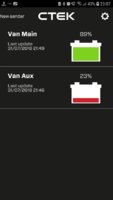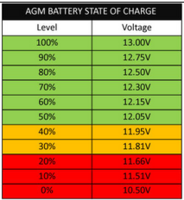You are using an out of date browser. It may not display this or other websites correctly.
You should upgrade or use an alternative browser.
You should upgrade or use an alternative browser.
Stop/start...regen...smart Alternator... Dc-dc Charger For Leisure Battery Or Not?
- Thread starter Dellmassive
- Start date
And it's also now clear to me WHY the splicharge relay setup doesn't work.
The Euro6 arrangement has a current shunt on the negative post of the main starter battery to meter the flow of power in and out of the battery.
The ECU then adapts the charge strategy to keep the main starter battery @ around 80% SOC state of charge.
At no point is there a feed back circuit for the aux battery to the ECU or a current shunt on it.
So the ECU has no idea of the charge level or drain of the AUX battery and frankly it doesn't care.
VW has just gone for the cheap option of fitting the Euro5 style split charge relay.....but made some inroads by making the AUX battery a EPC cheap alternative to a proper AGM battery.
Net result...... a mostly flat aux battery.
Conclusion...... fit a DC-DC charger.
But it's still worth taking the factory AUX option as you get a battery.brackets.cables.bcm switch feed Etc Etc Etc pre fitted for a reasonable price...just swap out the relay for the dc-dc charger after.
The Euro6 arrangement has a current shunt on the negative post of the main starter battery to meter the flow of power in and out of the battery.
The ECU then adapts the charge strategy to keep the main starter battery @ around 80% SOC state of charge.
At no point is there a feed back circuit for the aux battery to the ECU or a current shunt on it.
So the ECU has no idea of the charge level or drain of the AUX battery and frankly it doesn't care.
VW has just gone for the cheap option of fitting the Euro5 style split charge relay.....but made some inroads by making the AUX battery a EPC cheap alternative to a proper AGM battery.
Net result...... a mostly flat aux battery.
Conclusion...... fit a DC-DC charger.
But it's still worth taking the factory AUX option as you get a battery.brackets.cables.bcm switch feed Etc Etc Etc pre fitted for a reasonable price...just swap out the relay for the dc-dc charger after.
Stage 1:
This all started because I wanted Solar.....
In my current Victron Collection:
MTTP 15/75 Fitted - looking at at how much power you have harvested throughout the day is very addictive
Smart Battery Monitor - Waiting to be fitted
800w Inverter - Waiting to be fitted
After a bit more research following my trawl for a new battery I now have planned:
Victron Charger
Victron Battery Protect
Extreme 110 AGM Battery
Redarc 1225
Satge 2:
Rasberry Pi with permanent wifi - allowing me to monitor the van electrics from anywhere
Alexa Spot controlling mood lighting and sound system via built-in bluetooth soundbar
I've resisted with the electrical gadgets for the past 2 yesrs.....but I'm an Aircraft avionics Engineer by trade so its in my blood!.....Last van had an Xbox and a full PC setup running on 12v.
This all started because I wanted Solar.....
In my current Victron Collection:
MTTP 15/75 Fitted - looking at at how much power you have harvested throughout the day is very addictive
Smart Battery Monitor - Waiting to be fitted
800w Inverter - Waiting to be fitted
After a bit more research following my trawl for a new battery I now have planned:
Victron Charger
Victron Battery Protect
Extreme 110 AGM Battery
Redarc 1225
Satge 2:
Rasberry Pi with permanent wifi - allowing me to monitor the van electrics from anywhere
Alexa Spot controlling mood lighting and sound system via built-in bluetooth soundbar
I've resisted with the electrical gadgets for the past 2 yesrs.....but I'm an Aircraft avionics Engineer by trade so its in my blood!.....Last van had an Xbox and a full PC setup running on 12v.
@Dellmassive your last post has got me thinking - I have the 180 EURO 5 engine without the dual battery setup - my converter has used a VSR to charge the leisure battery, until yesterday I was blind to the Smart Alternator / re-gen issues.
I'm wondering if the 180 EURO 5 affected in the same way i.e. does it have re-gen braking? - obviously it has the start / stop tech.
I'm wondering if the 180 EURO 5 affected in the same way i.e. does it have re-gen braking? - obviously it has the start / stop tech.
Yes your right. Sorry I was generalizing.
Some of the later euro5 models had stop/start. Though they didn't come with the adblue system Etc.
So basically if you have start/stop. Current sensor on the neg battery post. AGM battery. ..... your leisure battery will be affected if a VSR or relay is used.
You can check your self with multimeter.
On a non smart alternator You will see battery voltage on 12.6v and 13.8v constantly when engine running.
Smart systems would see mostly 12.6 battery voltage. But then 15.0v under braking.(unless you switch on a heavy load in which the ecm will request more from the alternator say 13.9v.)
Some of the later euro5 models had stop/start. Though they didn't come with the adblue system Etc.
So basically if you have start/stop. Current sensor on the neg battery post. AGM battery. ..... your leisure battery will be affected if a VSR or relay is used.
You can check your self with multimeter.
On a non smart alternator You will see battery voltage on 12.6v and 13.8v constantly when engine running.
Smart systems would see mostly 12.6 battery voltage. But then 15.0v under braking.(unless you switch on a heavy load in which the ecm will request more from the alternator say 13.9v.)
Thanks for inspiring read. A few thoughts came into my mind…
What bothers me is why your leisure battery would be in such a different state than the starter battery. Especially as the leisure battery has no load discharging it. Have you verified the CTEK voltage monitors by connecting them to the same battery and see if they then give identical readings?
Using stock split charge relay when engine is running the leisure battery is most of the time connected parallel with starter battery. Except of course disconnected when engine is cranked. So being tied together actually I would expect the leisure battery to have the same voltage as the main battery and thus they should be at same state of charge eventually.
From ECU’s point of view the leisure battery is just another load drawing current from the alternator or from the starter battery. Which it simply does as long as its voltage is lower than voltage of the starter battery. In my thinking for the ECU there is no real need to separately monitor the status of leisure battery. The ECU really cares only about being capable to start the engine, not if you have enough capacity to run your electric tools (beer cooler) while camping. However, I do recognize the situation when the batteries are not any more a “balanced” pair due to aging or failures. Then independent charging would be useful.
For me a kind of concern is that using the stock relay the leisure battery is never fully charged but instead at the same level as main battery. Which by the way, according to van’s own battery monitoring (module 61) means that available battery charge is usually less than 50% of battery’s nominal capacity.
For me “not the full capacity” might be an issue in winters because my van runs Webasto engine/cabin preheater daily from the leisure battery before starting the engine – so I prefer to have it fully charged whenever possible. This was my main justification for a DC-DC charger for the leisure battery.
What bothers me is why your leisure battery would be in such a different state than the starter battery. Especially as the leisure battery has no load discharging it. Have you verified the CTEK voltage monitors by connecting them to the same battery and see if they then give identical readings?
Using stock split charge relay when engine is running the leisure battery is most of the time connected parallel with starter battery. Except of course disconnected when engine is cranked. So being tied together actually I would expect the leisure battery to have the same voltage as the main battery and thus they should be at same state of charge eventually.
From ECU’s point of view the leisure battery is just another load drawing current from the alternator or from the starter battery. Which it simply does as long as its voltage is lower than voltage of the starter battery. In my thinking for the ECU there is no real need to separately monitor the status of leisure battery. The ECU really cares only about being capable to start the engine, not if you have enough capacity to run your electric tools (beer cooler) while camping. However, I do recognize the situation when the batteries are not any more a “balanced” pair due to aging or failures. Then independent charging would be useful.
For me a kind of concern is that using the stock relay the leisure battery is never fully charged but instead at the same level as main battery. Which by the way, according to van’s own battery monitoring (module 61) means that available battery charge is usually less than 50% of battery’s nominal capacity.
For me “not the full capacity” might be an issue in winters because my van runs Webasto engine/cabin preheater daily from the leisure battery before starting the engine – so I prefer to have it fully charged whenever possible. This was my main justification for a DC-DC charger for the leisure battery.
A snapshot from a two year old T6 having factory installed leisure battery. The batteries are identical Varta 75Ah AGM. Split charge relay is the stock one. So these numbers are just for the starter battery. My assumption is they would be close for the leisure battery, too. Measuring the voltages of the batteries seems to support the assumption – when measurements are done next morning so that all the chemical reactions due to charging have stabilized.
Tuesday,November,2017
Address 61: Battery Regul. (7E0 907 534 )
10.0°C Battery Temperature
79.0 % Battery Level
78.0 % Battery Aging (Power)
69.0 % Battery Aging (Charge)
7.4 mOhm Internal Resistance Battery
7.6 mOhm Internal Resistance Battery (normalized)
31 Ah Available Battery Charge
Tuesday,November,2017
Address 61: Battery Regul. (7E0 907 534 )
10.0°C Battery Temperature
79.0 % Battery Level
78.0 % Battery Aging (Power)
69.0 % Battery Aging (Charge)
7.4 mOhm Internal Resistance Battery
7.6 mOhm Internal Resistance Battery (normalized)
31 Ah Available Battery Charge
Hi MMI . . . .
Agreed and no, but i have retested the battery with a separate meter, but a good call and ill do that test.
Agreed, thats what i thought and would expect . . . .
.
Agreed, again it all makes sense on paper..
.
Agreed again . .
Yep, totally . . . same here, we wanted to fully understand the setup before connecting any heavy loads. . . . .
so, just this morning i done another test . . . . . and as you can see the batteries are not balanced . . . why? - i have no idea?
this is the OEM main starter battery . . . . . .
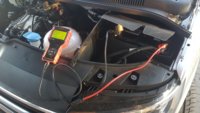
this is the readout after a nights worth of resting . . . .
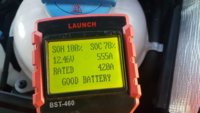
so,
SOC @ 78%,
12.46v
SOH @ 100%
this is the facoty AUX battery . . . . . . . .
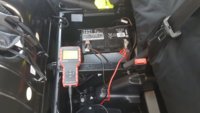
and the readout . . . . .
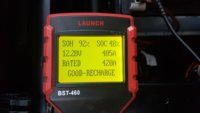
so,
SOC @ 48%,
12.28v
SOH @ 92%
As you said above, i dont make sense, but it should do?
i have no idea why the batteries are so far out of balance, maybe because the AUX feed cables are thinner and longer? . . . . i just dont know.
but the testing does prove the point that for some reason the AUX battery is always under charged / ., . ., , ,. ,. ,. dont know why though.
No heres the realy interesting thing . . . .
this morning i refitted the REDARC and these are the readouts just now after a day out working . . . . .
this is the CTEK readouts . . . .
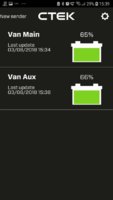
ignore the fact they are at 60% odd as I've been working on the van for a couple of hours with the LED lights etc running . . . . but look at how close the balance is now!!
and heres the volts readout from the BM2 of the AUX battery . . . .
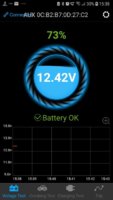
again it shows a marked improvement and increase in charge and capacity . . . . . . . . . .
so tatally agreed with everything you said above, but the testing seems to show otherwise . . . . . . . .
plus may other members having issues with a less than fully charged AUX battery when using the OEM relay or a VSR setup . . . . . ??
and also i have personally witnessed the inrush of current (with a clamp meter) from the AUX battery back over to the starter battery with a clamp meter as @Loz showed on his smart current meter when the starter battery is lower than the AUX battery....
The only conclusion i have is that that even though you would expect both batteries to be the same, the loads on the van demand current. . . . .
this should come from the alternator when the engines running, but because euro6 setup shuts off the smart alternator that current demand is sourced from both batteries via the relay.
The ECM monitors the SOC of the starter battery but is not accounting for the possible 50% off that currant draw from the AUX battery when the engine is running 50% Aux & 50% starter..
so im assuming that the EMC is not accounting for the 50% of supplied current back flowing from the AUX battery to supplement the starter battery when the smart alternator is not generating enough amps . . .
I think the ECM is just watching for the volt drop when high loads are switched on and only generates enough current to overcome the voltdrop raising the voltage to its preset level . . .
Now, i think the Aux battery is low on SOC because its not seeing its 15amps bulk/Absorption charge current for 2-3hours to bulk it up........its just seeing pulses of 15v under regen and because the ECM is seeing the NET average voltage of both batteries and assumes all is well.....
Now when you add the REDARC into the setup it has effectively a 1way diode to stop any back flow of currant from the Aux battery to the starter . . . . . . so now any availible currant is used to increase the SOC of the AUX battery.
it then uses the 3stage process to charge the Aux battery . . . .
so my conclusion is that the ECM is not factoring in the back flow of currant from the Aux battery, and just working from data from the starter currant shunt which effectively is only monitoring 50% of the available battery "bank" when the relay or VSR is engaged and connecting both batteries together . . . . . . . and dont forget the smart alternator is not shunted either . . . . .so the ECM is not metering out the current in amps generated from the alternator . . . . . only the voltage to overcome the volt drop. . . .
Thats my take on it all anyway and welcome new ideas or thoughts. . . . . . . .
What bothers me is why your leisure battery would be in such a different state than the starter battery. Especially as the leisure battery has no load discharging it. Have you verified the CTEK voltage monitors by connecting them to the same battery and see if they then give identical readings?
Agreed and no, but i have retested the battery with a separate meter, but a good call and ill do that test.
Using stock split charge relay when engine is running the leisure battery is most of the time connected parallel with starter battery. Except of course disconnected when engine is cranked. So being tied together actually I would expect the leisure battery to have the same voltage as the main battery and thus they should be at same state of charge eventually.
Agreed, thats what i thought and would expect . . . .
.
From ECU’s point of view the leisure battery is just another load drawing current from the alternator or from the starter battery. Which it simply does as long as its voltage is lower than voltage of the starter battery. In my thinking for the ECU there is no real need to separately monitor the status of leisure battery. The ECU really cares only about being capable to start the engine, not if you have enough capacity to run your electric tools (beer cooler) while camping. However, I do recognize the situation when the batteries are not any more a “balanced” pair due to aging or failures. Then independent charging would be useful.
Agreed, again it all makes sense on paper..
.
For me a kind of concern is that using the stock relay the leisure battery is never fully charged but instead at the same level as main battery. Which by the way, according to van’s own battery monitoring (module 61) means that available battery charge is usually less than 50% of battery’s nominal capacity.
Agreed again . .
For me “not the full capacity” might be an issue in winters because my van runs Webasto engine/cabin preheater daily from the leisure battery before starting the engine – so I prefer to have it fully charged whenever possible. This was my main justification for a DC-DC charger for the leisure battery.
Yep, totally . . . same here, we wanted to fully understand the setup before connecting any heavy loads. . . . .
so, just this morning i done another test . . . . . and as you can see the batteries are not balanced . . . why? - i have no idea?
this is the OEM main starter battery . . . . . .

this is the readout after a nights worth of resting . . . .

so,
SOC @ 78%,
12.46v
SOH @ 100%
this is the facoty AUX battery . . . . . . . .

and the readout . . . . .

so,
SOC @ 48%,
12.28v
SOH @ 92%
As you said above, i dont make sense, but it should do?
i have no idea why the batteries are so far out of balance, maybe because the AUX feed cables are thinner and longer? . . . . i just dont know.
but the testing does prove the point that for some reason the AUX battery is always under charged / ., . ., , ,. ,. ,. dont know why though.
No heres the realy interesting thing . . . .
this morning i refitted the REDARC and these are the readouts just now after a day out working . . . . .
this is the CTEK readouts . . . .

ignore the fact they are at 60% odd as I've been working on the van for a couple of hours with the LED lights etc running . . . . but look at how close the balance is now!!
and heres the volts readout from the BM2 of the AUX battery . . . .

again it shows a marked improvement and increase in charge and capacity . . . . . . . . . .
so tatally agreed with everything you said above, but the testing seems to show otherwise . . . . . . . .
plus may other members having issues with a less than fully charged AUX battery when using the OEM relay or a VSR setup . . . . . ??
and also i have personally witnessed the inrush of current (with a clamp meter) from the AUX battery back over to the starter battery with a clamp meter as @Loz showed on his smart current meter when the starter battery is lower than the AUX battery....
The only conclusion i have is that that even though you would expect both batteries to be the same, the loads on the van demand current. . . . .
this should come from the alternator when the engines running, but because euro6 setup shuts off the smart alternator that current demand is sourced from both batteries via the relay.
The ECM monitors the SOC of the starter battery but is not accounting for the possible 50% off that currant draw from the AUX battery when the engine is running 50% Aux & 50% starter..
so im assuming that the EMC is not accounting for the 50% of supplied current back flowing from the AUX battery to supplement the starter battery when the smart alternator is not generating enough amps . . .
I think the ECM is just watching for the volt drop when high loads are switched on and only generates enough current to overcome the voltdrop raising the voltage to its preset level . . .
Now, i think the Aux battery is low on SOC because its not seeing its 15amps bulk/Absorption charge current for 2-3hours to bulk it up........its just seeing pulses of 15v under regen and because the ECM is seeing the NET average voltage of both batteries and assumes all is well.....
Now when you add the REDARC into the setup it has effectively a 1way diode to stop any back flow of currant from the Aux battery to the starter . . . . . . so now any availible currant is used to increase the SOC of the AUX battery.
it then uses the 3stage process to charge the Aux battery . . . .
so my conclusion is that the ECM is not factoring in the back flow of currant from the Aux battery, and just working from data from the starter currant shunt which effectively is only monitoring 50% of the available battery "bank" when the relay or VSR is engaged and connecting both batteries together . . . . . . . and dont forget the smart alternator is not shunted either . . . . .so the ECM is not metering out the current in amps generated from the alternator . . . . . only the voltage to overcome the volt drop. . . .
Thats my take on it all anyway and welcome new ideas or thoughts. . . . . . . .
Now this is even more confusing. Do you have an idea why the State of Health (SOH) of the aux battery has already (date Nov-2017 on the battery cable, so a brand new van? ) dropped so much (to 92%), or actually what the SOH means on this meter? Did you check is the SOH reading of aux battery still the same after refitting the DC-DC-charger and having fully charged aux battery?
) dropped so much (to 92%), or actually what the SOH means on this meter? Did you check is the SOH reading of aux battery still the same after refitting the DC-DC-charger and having fully charged aux battery? An example on page 13 in the tester's user manual suggests that SOH of 46% means the battery is possibly at the end of its service life, so being already down to 92%...
An example on page 13 in the tester's user manual suggests that SOH of 46% means the battery is possibly at the end of its service life, so being already down to 92%...
Anyways, no question that having a separate DC-DC-charger for aux battery is a good thing capacitywise. Another thing I think is not yet mentioned here is that when replacing a battery - if having just the factory split charge relay, probably makes sense to replace both.
Anyhoo, I’ll put the factory relay back in and see how my van then treats the aux battery.
State of Charge measurement using just a voltmeter is simple but has quite a few limitations and conditions to get comparable results. Some more to read in http://batteryuniversity.com/learn/article/how_to_measure_state_of_charge
Will do additional measurements after a decent stabilization period as suggested by the link. Need to hang the wires outside the van so that I can measure without “waking up” the van by unlocking and/or opening a door or bonnet. Also need to do a few more runs during next few days to see how things evolve as the aux battery was fully charged by the DC-DC charger. The aux battery will be in open circuit – no load. Unfortunately the main battery serves all night van’s housekeeping functions – probably a total of a few tens of milliamps for battery monitoring itself, door remote receiver, aux heater receiver, alarm.
 ) dropped so much (to 92%), or actually what the SOH means on this meter? Did you check is the SOH reading of aux battery still the same after refitting the DC-DC-charger and having fully charged aux battery?
) dropped so much (to 92%), or actually what the SOH means on this meter? Did you check is the SOH reading of aux battery still the same after refitting the DC-DC-charger and having fully charged aux battery? An example on page 13 in the tester's user manual suggests that SOH of 46% means the battery is possibly at the end of its service life, so being already down to 92%...
An example on page 13 in the tester's user manual suggests that SOH of 46% means the battery is possibly at the end of its service life, so being already down to 92%...Sorry to add more confusion here but the Module 61- Battery regulator does meter also alternator current. Grabbed this one having engine on tick over after a short drive. Though a different van having 92Ah main battery and 75Ah aux battery, both the same type of Varta AGM.so my conclusion is that the ECM is not factoring in the back flow of currant from the Aux battery, and just working from data from the starter currant shunt which effectively is only monitoring 50% of the available battery "bank" when the relay or VSR is engaged and connecting both batteries together . . . . . . . and dont forget the smart alternator is not shunted either . . . . .so the ECM is not metering out the current in amps generated from the alternator . . . . . only the voltage to overcome the volt drop. . . .
Address 61: Battery Regul. (7E0 907 534 )
13.248 V Battery Voltage
2.8 A Battery Current
36.0°C Battery Temperature
6.6 mOhm Internal Resistance Battery (normalized)
49 Ah Available Battery Charge
12.50 V Battery Quiescent Current
37.6 A Generator Current
119.2 A Generator Current Reserve
13.248 V Battery Voltage
2.8 A Battery Current
36.0°C Battery Temperature
6.6 mOhm Internal Resistance Battery (normalized)
49 Ah Available Battery Charge
12.50 V Battery Quiescent Current
37.6 A Generator Current
119.2 A Generator Current Reserve
Anyways, no question that having a separate DC-DC-charger for aux battery is a good thing capacitywise. Another thing I think is not yet mentioned here is that when replacing a battery - if having just the factory split charge relay, probably makes sense to replace both.
Anyhoo, I’ll put the factory relay back in and see how my van then treats the aux battery.
State of Charge measurement using just a voltmeter is simple but has quite a few limitations and conditions to get comparable results. Some more to read in http://batteryuniversity.com/learn/article/how_to_measure_state_of_charge
Will do additional measurements after a decent stabilization period as suggested by the link. Need to hang the wires outside the van so that I can measure without “waking up” the van by unlocking and/or opening a door or bonnet. Also need to do a few more runs during next few days to see how things evolve as the aux battery was fully charged by the DC-DC charger. The aux battery will be in open circuit – no load. Unfortunately the main battery serves all night van’s housekeeping functions – probably a total of a few tens of milliamps for battery monitoring itself, door remote receiver, aux heater receiver, alarm.
Put the factory relay back in. Hooked a computer for two hours into aux battery to discharge it a bit as the battery had been pampered by a dc-dc charger.
Took the van for a short drive, did some shopping and other usual Saturday stuff. About 30 mins total engine running.
Wired the van so that can read the voltages without waking her up.
A good write-up of the measurement: Battery State of Charge using a Voltmeter
Anyways, next week I’ll do a couple of long drives. I’ll add/edit the results here.
Took the van for a short drive, did some shopping and other usual Saturday stuff. About 30 mins total engine running.
Wired the van so that can read the voltages without waking her up.
After 8 hour rest (using the same multimeter for both measurements to eliminate any offset errors):
Test 1 (Aug-04)):
START of EDIT (8.9.2018) -----Test 1 (Aug-04)):
Aux battery 12,70 V
Main battery 12,58 V
Main battery 12,58 V
Test 2 (Aug-08) after 3 hour drive
Also verified that my cheap multimeter is in the right ballbark. Not too bad on this one (on the right). But obviously the quality goes with the price.


END of EDIT (8.9.2018) -----Aux battery 12,72 V (3 hour rest)
Main battery 12,43 (3 hour rest, but several door lock/unlocks etc)
Test 3 (Aug-09) after another 3 hour driveMain battery 12,43 (3 hour rest, but several door lock/unlocks etc)
Aux battery 12,72 V (10 hour rest)
Main battery 12,55 V (10 hour rest but connected to the van, unloading the van last night, continuous housekeeping current over night, etc.)
So my conclusion is that the OEM split charge system works as advertized. When engine is stopped the aux battery is disconnected from van's main battery and the state of charge to begin with is close to main battery's. The SOC measurements above as such are just an approximations as stated in referenced links. Anyways the SOC of the aux battery is in the right ball park - at about 80% because the van uses constant coltage charging and the main and aux batteries are tightly connected together when engine is running.Main battery 12,55 V (10 hour rest but connected to the van, unloading the van last night, continuous housekeeping current over night, etc.)
Also verified that my cheap multimeter is in the right ballbark. Not too bad on this one (on the right). But obviously the quality goes with the price.


Attached a table from Deep Cycle Batteries | A Guide to the best Deep Cycle Batteries for Solar, Camping, Caravan & 4WDs which categorizes both values to same SOC "class" of about 80-90%.
A good write-up of the measurement: Battery State of Charge using a Voltmeter
Anyways, next week I’ll do a couple of long drives. I’ll add/edit the results here.
Last edited:
Got a little too excited on this. The link https://batteryuniversity.com/index.php/learn/article/how_to_measure_state_of_charge suggests that AGM type of battery produces slightly higher voltage than the flooded ones. The attached table seems to align with the statement.
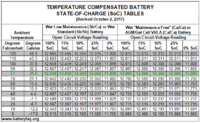
The table is a stripped down version (specific gravity readings omitted) of a larger table on site batteryfaq.org

The table is a stripped down version (specific gravity readings omitted) of a larger table on site batteryfaq.org
Last edited:
P
Phil_G
Guest
Those Ctek CTX battery monitors are so expensive and I see some have one for each battery - ninety quids worth?
Mine is just one simple homebrew unit that cost twopence ha'penny, monitors both batteries and reports over bluetooth to
your phone. Connections are just three wires, ground, leisure pos & starter pos via pins shoved into the cables then insulated.
I connected it either side of the (controversial) VW split charge relay. When the relay is operated of course the voltages are
the same but at that point you're driving and hopefully not looking at the phone! You can add complexity to your hearts
content - current, amp-hours, low voltage warnings, logging, whatever but in its simplest form I wouldnt mind making a few (?)
but in its simplest form I wouldnt mind making a few (?)
Cheers
Phil
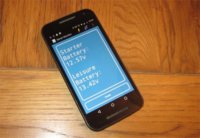
Mine is just one simple homebrew unit that cost twopence ha'penny, monitors both batteries and reports over bluetooth to
your phone. Connections are just three wires, ground, leisure pos & starter pos via pins shoved into the cables then insulated.
I connected it either side of the (controversial) VW split charge relay. When the relay is operated of course the voltages are
the same but at that point you're driving and hopefully not looking at the phone! You can add complexity to your hearts
content - current, amp-hours, low voltage warnings, logging, whatever
Cheers
Phil

Last edited by a moderator:
The new BM2 battery monitor is cheaper at about £26 and had much better software for monitoring....... worth a look too.
https://www.amazon.co.uk/Kolsol-QUI...C_SX236_SY340_QL65&keywords=bm2+battery&psc=1
https://www.amazon.co.uk/Kolsol-QUI...C_SX236_SY340_QL65&keywords=bm2+battery&psc=1
Any details of the implementation you could share? The chip?Those Ctek CTX battery monitors are so expensive and I see some have one for each battery - ninety quids worth?
Mine is just one simple homebrew unit that cost twopence ha'penny, monitors both batteries and reports over bluetooth to
your phone. Connections are just three wires, ground, leisure pos & starter pos via pins shoved into the cables then insulated.
I connected it either side of the (controversial) VW split charge relay. When the relay is operated of course the voltages are
the same but at that point you're driving and hopefully not looking at the phone! You can add complexity to your hearts
content - current, amp-hours, low voltage warnings, logging, whateverbut in its simplest form I wouldnt mind making a few (?)
Cheers
Phil
View attachment 26933
I like the ctek ones, they do one thing and they do it very well. It’s useful to get a slick and accurate timeseries of charge levels. They also aren’t confused by voltages varying from load/alternator/solar - they just give a (from what I can tell) accurate estimate at all times.
Any details of the implementation you could share? The chip?
I would be interested too please.
Pete
My CTEK has frozen twice now. The only way to reset it is disconnect it from the battery. Bit of a ball ache as it means removing the passenger seatI like the ctek ones, they do one thing and they do it very well. It’s useful to get a slick and accurate timeseries of charge levels. They also aren’t confused by voltages varying from load/alternator/solar - they just give a (from what I can tell) accurate estimate at all times.

My CTEK has frozen twice now. The only way to reset it is disconnect it from the battery. Bit of a ball ache as it means removing the passenger seat
I feel your pain! My couple have been totally reliable (so far...). Might be worth badgering ctek to see if they’ll replace under warranty.
P
Phil_G
Guest
Theres really nothing to it, it was a very quick project that I intended to pursue but havent touched in ages...Any details of the implementation you could share? The chip?
Its just a Pro-Mini with an HC06 on the serial lines, and the freebie monitor app, its probably more accurate than the 'cheap' commercial ones as I think they use the internal reference, whereas mine has an LM4040 precision ref. I'll write it up properly if theres any interest.
Cheers
Phil
Last edited by a moderator:
Theres really nothing to it, it was a very quick project that I intended to pursue but havent touched in ages...
Its just a Pro-Mini with an HC06 on the serial lines, and the freebie monitor app. I'll write it up properly if theres any
interest.
Cheers
Phil
A quick write-up would be great thanks - along with some links where appropriate to reading material.
Pete
Similar threads
- Replies
- 4
- Views
- 425
- Replies
- 21
- Views
- 2K
- Replies
- 36
- Views
- 2K
- Replies
- 5
- Views
- 596

